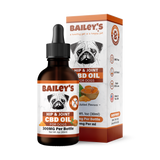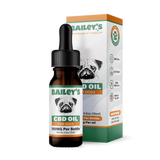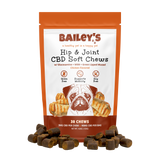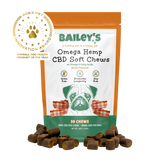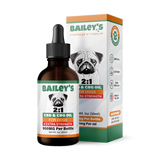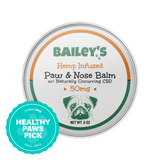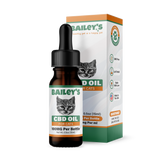Black-Eyed Peas for Dogs: Canine Consumption
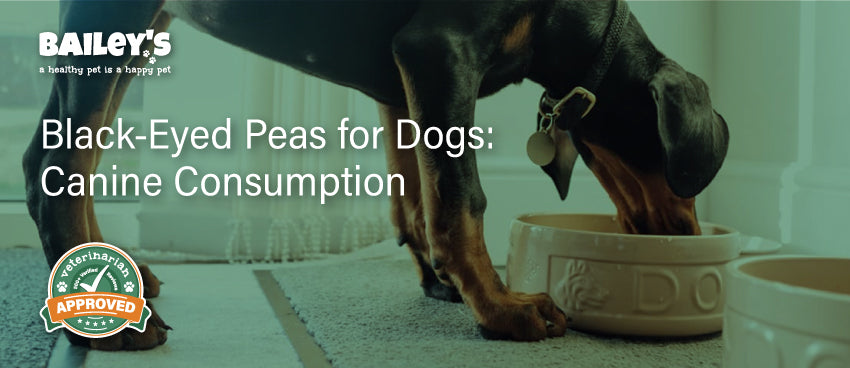
When it comes to our beloved furry friends, ensuring they receive a well-balanced diet is of utmost importance. But have you ever wondered if black-eyed peas can be a part of their diet? Let's learn from our friends at Bailey’s CBD as we delve into the nutritional value of black-eyed peas and find out.

Table of Contents
- 1. Understanding the Nutritional Value of Black-Eyed Peas
- 2. Potential Health Benefits for Dogs
- 3. Preparing Black-Eyed Peas for Your Dog
- 4. Possible Risks and Precautions
- 5. Consulting Your Vet about Your Dog's Diet
- 5.1 When to Discuss Dietary Changes with Your Vet
- 5.2 Understanding Your Dog's Unique Nutritional Needs
- 6. Conclusion
Featured Product ⭐:
 Bailey's World Famous CBD Oil For Dogs
Bailey's World Famous CBD Oil For Dogs
- Available in 3 bottle sizes:
- 150mg - 1/2oz - 15ml Bottle
- 300mg - 1oz - 30ml Bottle
- 600mg - 2oz - 60ml Bottle
Special Offer: Use code TRYBAILEYS50 for 50% off your first order!
1. Understanding the Nutritional Value of Black-Eyed Peas
Black-eyed peas are not only a delicious addition to our meals, but they also offer a wide range of health benefits for our canine companions. These small, creamy legumes are packed with essential vitamins, minerals, and protein that can contribute to your dog's overall well-being.
1.1 Key Vitamins and Minerals in Black-Eyed Peas
Black-eyed peas are a nutritional powerhouse for dogs. They contain essential vitamins such as vitamin A, vitamin C, and vitamin K. These vitamins play a vital role in maintaining your dog's overall health, including supporting their immune system, promoting proper bone and tooth development, and aiding in blood clotting.
Vitamin A, found abundantly in black-eyed peas, is crucial for your dog's vision and skin health. It helps maintain the integrity of their mucous membranes and supports the growth and repair of tissues throughout their body.
Vitamin C, known for its antioxidant properties, helps protect your dog's cells from damage caused by free radicals. It also plays a role in collagen synthesis, which is essential for healthy skin, joints, and connective tissues.
Vitamin K, another important nutrient found in black-eyed peas, is necessary for proper blood clotting. It helps prevent excessive bleeding and ensures that wounds heal effectively.
In addition to vitamins, black-eyed peas are rich in minerals like potassium, magnesium, and iron. These minerals are essential for proper nerve function, muscle contractions, and the production of red blood cells in dogs.
Potassium, an electrolyte, helps maintain the balance of fluids in your dog's body and supports proper muscle and nerve function. It also plays a role in maintaining a healthy heart rhythm.
Magnesium, on the other hand, is involved in more than 300 enzymatic reactions in your dog's body. It contributes to energy production, protein synthesis, and the maintenance of strong bones and teeth.
Iron, a vital mineral found in black-eyed peas, is necessary for the production of hemoglobin, which carries oxygen to all parts of your dog's body. It helps prevent anemia and ensures that your dog's cells receive the oxygen they need to function properly.
Related Dog Health Article🐕🦺:
Dog Food Allergies: Identification and Management1.2 Protein Content in Black-Eyed Peas
Protein is a crucial component of any dog's diet, as it helps in the growth and repair of cells and tissues. Black-eyed peas are a great source of plant-based protein for dogs. While they cannot replace animal-based protein completely, incorporating black-eyed peas into your dog's diet can provide an additional protein boost. However, it is essential to remember that the protein content in black-eyed peas is lower compared to meat sources.
When feeding your dog black-eyed peas, it is important to consider their individual dietary needs and consult with your veterinarian. While black-eyed peas offer numerous nutritional benefits, they should be part of a balanced diet that includes other protein sources, such as lean meats or high-quality dog food.
Black-eyed peas can be a valuable addition to your dog's diet, providing essential vitamins, minerals, and plant-based protein. However, it is crucial to ensure that black-eyed peas are introduced in moderation and as part of a well-rounded meal plan. Always consult with your veterinarian to determine the appropriate portion sizes and dietary requirements for your furry friend.
Top Seller Product🥇:
Bacon-Flavored Omega Hemp CBD Soft Chews - Award Winning!Celebrated as the 2023 Pet Innovation Awards - Overall Pet Health Product of the Year.
2. Potential Health Benefits for Dogs
2.1 Digestive Health and Black-Eyed Peas
One of the significant benefits of including black-eyed peas in your dog's diet is their positive impact on digestive health. Black-eyed peas are high in dietary fiber, which aids in healthy digestion and can prevent common digestive issues such as constipation and diarrhea. Additionally, fiber promotes a feeling of fullness, making black-eyed peas a satisfying addition to your dog's meal.
Furthermore, the fiber found in black-eyed peas acts as a prebiotic, providing nourishment for the beneficial bacteria in your dog's gut. These bacteria play a crucial role in maintaining a healthy digestive system by breaking down food and absorbing essential nutrients. By promoting the growth of these beneficial bacteria, black-eyed peas support optimal gut health and overall well-being for your furry friend.
In addition to their fiber content, black-eyed peas are also a rich source of antioxidants. These powerful compounds help to reduce inflammation in the digestive tract, further supporting a healthy gut. By including black-eyed peas in your dog's diet, you are providing them with a natural and nutritious way to maintain digestive health.
Related Dog Digestive Health Article🐕🦺:
Bloating in Dogs: Causes, Symptoms, and CBD Relief2.2 Skin and Coat Health Benefits
Healthy skin and a glossy coat are indicators of a dog's overall well-being. The vitamins and minerals found in black-eyed peas, such as vitamin A and vitamin C, are essential for promoting healthy skin and a lustrous coat in dogs. Including black-eyed peas in their diet can contribute to a shinier coat and reduced skin dryness or irritation.
Vitamin A, found abundantly in black-eyed peas, plays a vital role in maintaining the health of your dog's skin cells. It helps to regulate the production of sebum, a natural oil that moisturizes the skin and prevents dryness. Adequate levels of vitamin A can also support the growth and repair of skin tissues, ensuring that your dog's skin remains healthy and resilient.
Additionally, the vitamin C content in black-eyed peas is known for its antioxidant properties. This vitamin helps to combat free radicals, which can damage the skin and lead to premature aging. By including black-eyed peas in your dog's diet, you are providing them with a natural source of vitamin C to support their skin's defense against oxidative stress.
Moreover, black-eyed peas are a good source of essential fatty acids, such as omega-3 and omega-6. These fatty acids play a crucial role in maintaining the integrity of the skin barrier, preventing moisture loss, and protecting against environmental irritants. By incorporating black-eyed peas into your dog's meals, you are helping to nourish their skin from within and promote a healthy, vibrant coat.
3. Preparing Black-Eyed Peas for Your Dog
Black-eyed peas can be a nutritious addition to your dog's diet, providing them with essential vitamins, minerals, and fiber. However, before serving black-eyed peas to your furry friend, it is crucial to take certain precautions to ensure their safety and well-being.
Related Dog Nutrition Articles🐕:
String Cheese for Dogs: Dietary ImpactScallops for Dogs: Feasibility and Safety
Almond Butter for Dogs: Canine Consumption
3.1 Cooking Methods for Black-Eyed Peas
When it comes to preparing black-eyed peas for your dog, cooking them thoroughly is of utmost importance. This not only improves their digestibility but also minimizes the risk of any potentially harmful bacteria that may be present.
There are a few different cooking methods you can choose from when it comes to black-eyed peas. One popular option is boiling them in water until they become soft and easily mashable. This method helps break down the peas, making them easier for your dog to digest.
Another cooking method is steaming the black-eyed peas. Steaming helps retain more of the nutrients compared to boiling, making it a healthier option for your dog. Simply place the peas in a steamer basket and steam them until they reach the desired tenderness.
Regardless of the cooking method you choose, it is important to avoid adding any seasonings, salt, or oil to the black-eyed peas. These additives can be harmful to your furry friend and may cause digestive issues or other health problems.

3.2 Serving Sizes and Frequency
When introducing black-eyed peas to your dog's diet, it is essential to start with small portions. This allows their digestive system to adjust gradually and reduces the risk of any adverse reactions.
Begin by offering a teaspoon-sized amount of cooked black-eyed peas and observe your dog's response. If they tolerate it well, you can gradually increase the serving size over a few days. However, if you notice any signs of digestive upset, such as diarrhea or vomiting, it is best to consult with your veterinarian before continuing.
The appropriate serving size of black-eyed peas for your dog depends on various factors, including their size, age, and overall dietary needs. Consulting with your veterinarian can help you determine the correct portion size and frequency of feeding black-eyed peas to your furry friend.
Remember, black-eyed peas should be considered as a supplement to your dog's regular diet and not a complete replacement. It is important to maintain a balanced and varied diet that meets all of their nutritional requirements.
By following these guidelines and taking the necessary precautions, you can safely incorporate black-eyed peas into your dog's diet, providing them with a healthy and delicious addition to their meals.
4. Possible Risks and Precautions
4.1 Allergic Reactions to Black-Eyed Peas
While black-eyed peas are generally safe for dogs, it's essential to remain vigilant for any signs of an allergic reaction. Some dogs may be allergic to legumes, including black-eyed peas. Watch out for symptoms such as itching, redness, swelling, or gastrointestinal upset. If you notice any adverse reactions, discontinue feeding black-eyed peas and consult your veterinarian.
4.2 Potential Digestive Issues
Although black-eyed peas can contribute to digestive health, overfeeding or introducing them too quickly into your dog's diet can lead to gastrointestinal issues. It is always best to introduce new foods gradually and in moderation. Monitor your dog for any signs of digestive distress such as bloating, gas, or diarrhea, and adjust the serving size accordingly.
Featured Non-CBD Product🌟:
Immunity Dog Chews: Bacon-Flavored, Mushroom-Enriched WellnessCrafted with 5 Defenders Mushrooms Blend, Colostrum, and Astragalus for optimal canine health. Deliciously cold pressed in bacon flavor - your dog's new favorite!
5. Consulting Your Vet about Your Dog's Diet
5.1 When to Discuss Dietary Changes with Your Vet
Every dog has unique nutritional needs, and it is always advisable to consult with your veterinarian before making any significant dietary, treatment, or supplement changes. This is especially important if your dog has pre-existing health conditions or is on a specific diet due to medical reasons. Your vet can guide you on whether black-eyed peas are suitable for your dog and recommend the ideal serving size and frequency.
5.2 Understanding Your Dog's Unique Nutritional Needs
While black-eyed peas offer some nutritional benefits, they should not replace a well-balanced dog food diet recommended by your veterinarian. Your vet will consider your dog's age, breed, weight, and specific health needs while determining their nutritional requirements. It's essential to provide a varied diet that meets all their nutritional needs and includes appropriate amounts of proteins, fats, carbohydrates, vitamins, and minerals.


